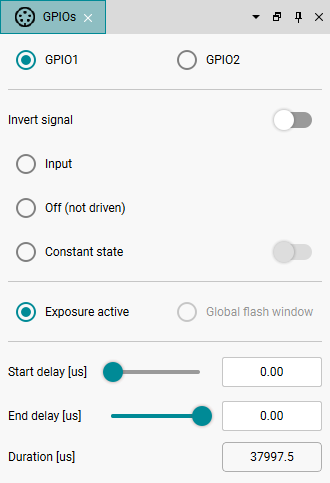
IDS peak 2.17.1 / uEye+ firmware 3.70
IDS Peak comfortSDK, genericSDK, IPL, and AFL developer manuals are external documents. Please contact us if you need them.
In the "GPIOs" dialog, you configure the settings of the GPIOs (model-dependent).
Click ![]() in the tool menu to open the dialog.
in the tool menu to open the dialog.

Fig. 247: GPIOs
In the upper area, you select whether GPIO 1 or GPIO 2 should be configured.
•Invert signal
Enables or disables whether the signal is inverted. The function is not available when "Off (not driven)" is selected.
•Input
The GPIO 1 (GPIO 2) is configured as input.
•Off (not driven)
The GPIO 1 (GPIO 2) is neither input nor output.
•Constant state
The GPIO 1 (GPIO 2) is in a constant state, i.e. it is controlled by " UserOutput1" (" UserOutput2"). Via the switch on the right, GPIO 1 (GPIO 2) is switched on and off independently of e.g. the exposure time. The settings for start delay, end delay or duration are inactive.
•Exposure active
The GPIO 1 (GPIO 2) behaves dynamically to the exposure time. The settings for start delay, end delay or duration are additionally used to control the flash signal.
•Global flash window
For rolling shutter sensors, you can switch between the exposure time and the global flash window.
•Start delay
You can set a start delay for the flash, i.e. after the exposure is started, the flash is delayed by the set time. Negative values are also possible, so that the flash can be enabled before the exposure starts.
•End delay
You can set an end delay for the flash, so that the flash is disabled e.g. already before the end of the exposure.
•Duration
Here, you specify how long the flash signal should be active. A value of 0 means that no flash signal is generated.